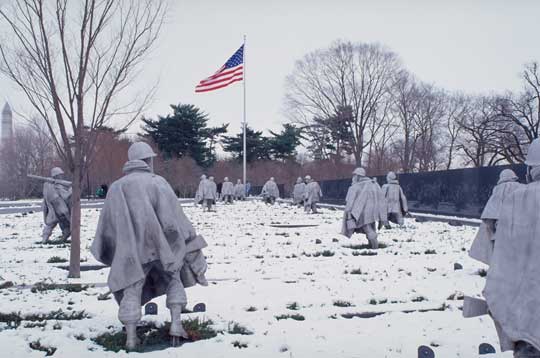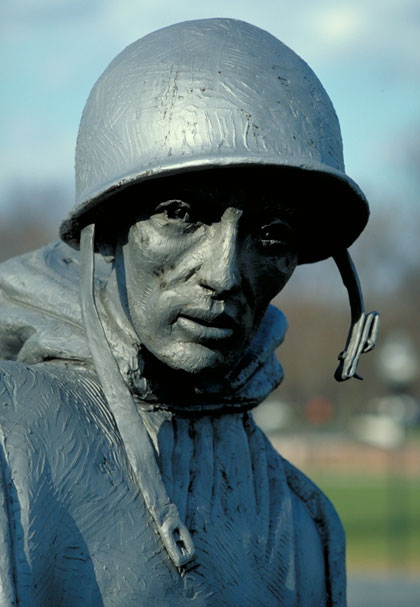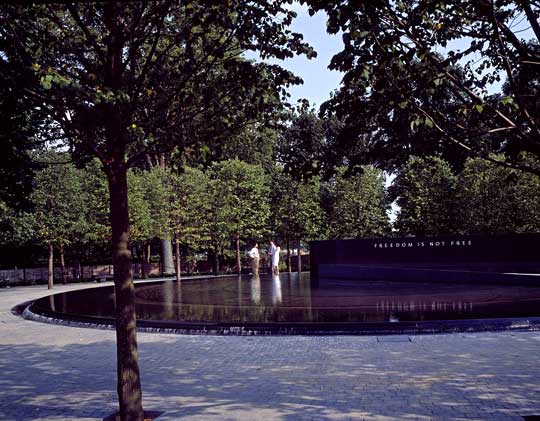
History of the Korean War Veterans Memorial
Dedicated in 1995, the Korean War Veterans Memorial lies a short distance to the southeast of the Lincoln Memorial, in Washington, D.C. It honors those who served in the Korean War, a conflict that began in June 1950 when North Korean forces, later backed by Chinese troops, invaded South Korea. Over three years, the United States, fighting under the United Nations flag with 21 other nations, fought the war to a stalemate.

The Korean War Veterans Memorial, on the National Mall in Washington, D.C. Nineteen American servicemen, by sculptor Frank Gaylord, advance across the Field of Service toward an American flag. © Peter R. Penczer.
If the experience of visiting the Vietnam Veterans Memorial is a somber communion with the dead, the Korean War Veterans Memorial is meant to evoke patriotism and the travails of the 1.5 million Americans who served in Korea. At the center of the memorial is the triangular Field of Service, where 19 statues of American soldiers, marines, and airmen walk up a gentle slope toward an American flag. The statues are the work of sculptor Frank Gaylord, of Barre, Vermont, himself a veteran of World War II.

The Korean War Veterans Memorial, showing the Field of Service before the present chain fence was installed. Credit: Library of Congress, Carol M. Highsmith Archive.
Seven and a half feet tall and made of stainless steel, the men are alert yet weary, draped in ponchos, and staggering under heavy loads against the weather. There is danger in the air, and they communicate among themselves through glances and words on open lips. They peer into the distance, drawing the visitor into the drama.

Frank Gaylord's sculptures capture the weariness and tension of troops in battle. © Peter R. Penczer.
Along one side of the field is a black granite wall, the work of graphic designer Louis Nelson of New York. Sandblasted into the wall are the faces of men and women—the doctors, nurses, truck drivers, clerks, and many others—who supported the combat troops. About 1,200 in number, their arrangement is reminiscent of an Asian scroll painting.

The Pool of Remembrance at the Korean War Veterans Memorial. Credit: Library of Congress, Carol M. Highsmith Archive.
At the head of the wall is the legend "Freedom Is Not Free" inlaid in silver. On the opposite side of the field is a curb with the names of the 22 allied nations. The wall and the curb join, intersecting a circular Pool of Remembrance, which is ringed with trees. Nearby are inscribed the numbers of American and United Nations dead, wounded, captured, and missing.
Congress authorized the memorial in 1986. Three years later, a jury selected a design by a team of four architects, all faculty members at Pennsylvania State University. Cooper-Lecky Architects of Washington, D.C., was hired to supervise the project. As the project progressed, the design was radically altered, and the four competition winners dropped out of the process after losing a lawsuit to block the changes. Ultimately, the memorial was a collaboration among many parties, but principally Cooper-Lecky, Gaylord, and the Commission of Fine Arts, which had authority over the design and location of the memorial.

An aerial view of the Korean War Veterans Memorial; Independence Avenue is on the right. Credit: Library of Congress, Carol M. Highsmith Archive.
The original design had 38 statues, for the armistice line at the 38th parallel, and the war, which ended in its 38th month. The number of statues was later reduced by half at the suggestion of the Commission of Fine Arts. President George H. W. Bush broke ground for the memorial in 1992. It was dedicated on July 27, 1995, the 42nd anniversary of the armistice that ended the war, by President Bill Clinton and President Kim Young Sam of South Korea.
Adapted with permission from The Washington National Mall, by Peter R. Penczer, Oneonta Press, Arlington, Va.: 2007.
Copyright © Peter R. Penczer 2016